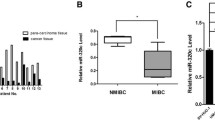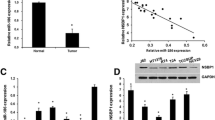Abstract
To investigate whether the miR-320a could regulate bladder cancer cells invasion by down-regulation of ITGB3. Real-time quantitative PCR was applied to evaluate the expression level of miRNA-320a in bladder transitional cell carcinomas (TCC) and normal bladder transitional cell (NBTC) samples. The invasion ability of miR-320a in TCC T24 cells was analyzed by Transwell assay after pre-miR-320a or anti-miR-125b transfection. For the invasion mechanism analysis of miR-320a on T24 cells, TargetScan, PicTar and miRBase were used to predict the possible target gene of miR-320a. Luciferase activities assay and western blot were used to reveal the predicted target gene of miR-320a were direct and specific. RNA interference technology was used to confirm the invasion inhibition of miR-320a was directly induced by ITGB3. Our study showed that miR-320a was down-regulated in human TCC specimens compared to that in NBTC specimens. Over-expression of miR-320a in T24 cells inhibited TCC invasion and this inhibitory effect on T24 cells could be restore by miR-320a knocked down. Mechanism analysis revealed that ITGB3 was a direct and specific target of miR-320a. The advanced effect of anti-miR-320a on TCC cell invasion was mediated by expression silence of ITGB3. In summary, aberrantly expressed miR-320a contribute to T24 cells invasion partly through directly down-regulating ITGB3 protein expression in TCC and this miRNA signature offers a novel potential therapeutic strategy for TCC.



Similar content being viewed by others
References
Murta-Nascimento C, Schmitz-Dräger BJ, Zeegers MP et al (2007) Epidemiology of urinary bladder cancer: from tumor development to patient’s death. World J Urol 25:285–295
Hassen W, Droller MJ (2000) Current concepts in assessment and treatment of bladder cancer. Curr Opin Urol 10:291–299
Ambros V, Chen X (2007) The regulation of genes and genomes by small RNAs. Development 134(9):1635–1641
Bartel DP (2004) MicroRNAs: genomics, biogenesis, mechanism, and function. Cell 116(2):281–297
Shang C, Lu YM, Meng LR (2012) MicroRNA-125b down-regulation mediates endometrial cancer invasion by targeting ERBB2. Med Sci Monit 18(4):BR149–BR155
Mendell JT (2005) MicroRNAs: critical regulators of development, cellular physiology and malignancy. Cell Cycle 4(9):1179–1184
Krek A, Grün D, Poy MN et al (2005) Combinatorial microRNA target predictions. Nat Genet 37(5):495–500
Chung TK, Lau TS, Cheung TH et al (2011) Dysregulation of microRNA-204 mediates migration and invasion of endometrial cancer by regulating FOXC1. Int J Cancer 130(5):1036–1045
Garzon R, Calin GA, Croce CM (2009) MicroRNAs in cancer. Annu Rev Med 60:167–179
Zhang Y, He X, Liu Y et al (2012) MicroRNA-320a inhibits tumor invasion by targeting neuropilin 1 and is associated with liver metastasis in colorectal cancer. Oncol Rep 27(3):685–694
Sun JY, Huang Y, Li JP et al (2012) MicroRNA-320a suppresses human colon cancer cell proliferation by directly targeting β-catenin. Biochem Biophys Res Commun 420(4):787–792
Malinin NL, Pluskota E, Byzova TV (2012) Integrin signaling in vascular function. Curr Opin Hematol 19(3):206–211
Taddei I, Faraldo MM, Teulière J et al (2003) Integrins in mammary gland development and differentiation of mammary epithelium. J Mammary Gland Biol Neoplasia 8(4):383–394
Hood JD, Cheresh DA (2002) Role of integrins in cell invasion and migration. Nat Rev Cancer 2(2):91–100
Lei Y, Huang K, Gao C et al (2011) Proteomics identification of ITGB3 as a key regulator in reactive oxygen species-induced migration and invasion of colorectal cancer cells. Mol Cell Proteomics 10(10):M110.005397
Al-Sahaf O, Wang JH, Browne TJ et al (2010) Surgical injury enhances the expression of genes that mediate breast cancer metastasis to the lung. Ann Surg 252(6):1037–1043
Kim JH, Zheng LT, Lee WH et al (2011) Pro-apoptotic role of integrin β3 in glioma cells. J Neurochem 117(3):494–503
Müller DW, Bosserhoff AK (2008) Integrin beta 3 expression is regulated by let-7a miRNA in malignant melanoma. Oncogene 27(52):6698–6706
Zaman MS, Shahryari V, Deng G et al (2012) Up-regulation of microRNA-21 correlates with lower kidney cancer survival. PLoS ONE 7(2):e31060
Li S, Chen T, Zhong Z et al (2012) MicroRNA-155 silencing inhibits proliferation and migration and induces apoptosis by upregulating BACH1 in bladder cancer cells. Mol Med Rep 5(4):949–954
Cimmino A, Calin GA, Fabbri M et al (2005) MiR-15 and miR-16 induce apoptosis by targeting BCL2. Proc Natl Acad Sci USA 102(39):13944–13949
Johnson SM, Grosshans H, Shingara J et al (2005) RAS is regulated by the let-7 microRNA family. Cell 120(5):635–647
O’Donnell KA, Wentzel EA, Zeller KI et al (2005) c-Myc-regulated microRNAs modulate E2F1 expression. Nature 435(7043):839–843
Griffiths-Jones S, Grocock RJ, van Dongen S et al (2006) MiRBase: microRNA sequences, targets and gene nomenclature. Nucleic Acids Res 34(Database issue):D140–D144
Acknowledgments
This work was supported by the National Nature Science Foundation of China (81172408, 30901480, 81301834, 81272716, 81301862).
Conflict of interest
None.
Author information
Authors and Affiliations
Corresponding author
Rights and permissions
About this article
Cite this article
Shang, C., Zhang, H., Guo, Y. et al. MiR-320a down-regulation mediates bladder carcinoma invasion by targeting ITGB3. Mol Biol Rep 41, 2521–2527 (2014). https://doi.org/10.1007/s11033-014-3110-0
Received:
Accepted:
Published:
Issue Date:
DOI: https://doi.org/10.1007/s11033-014-3110-0




